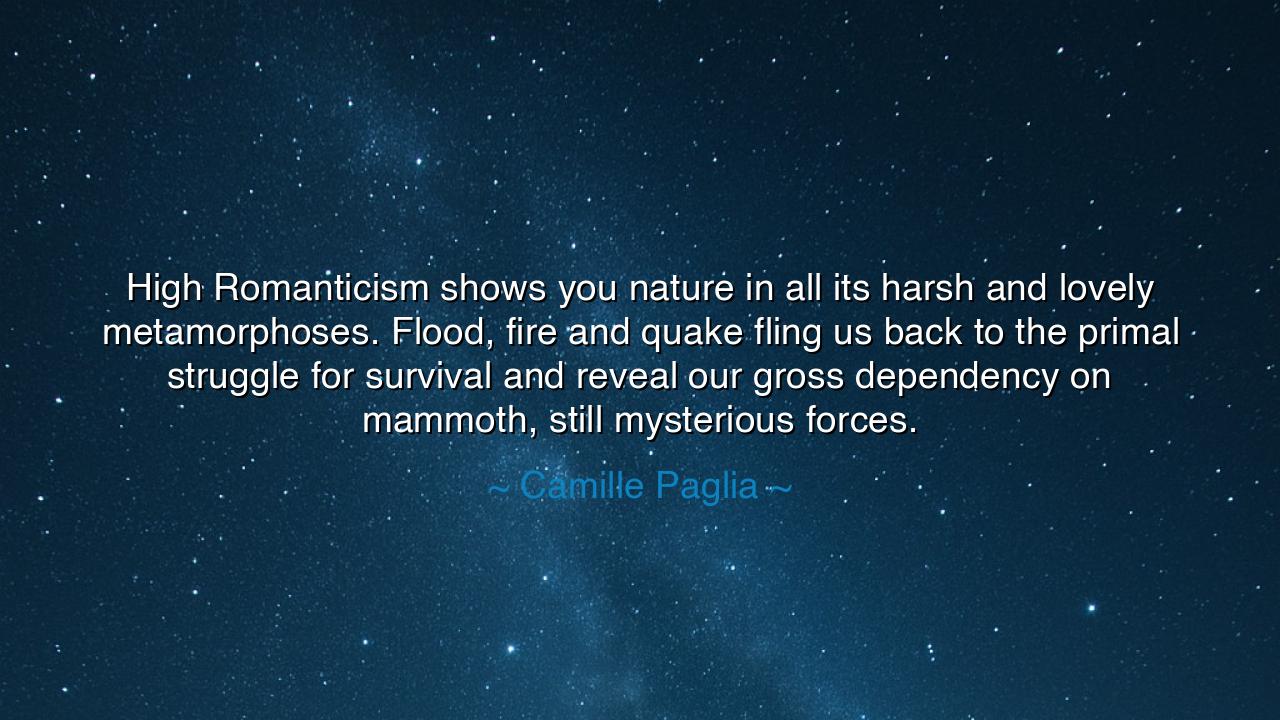
High Romanticism shows you nature in all its harsh and lovely
High Romanticism shows you nature in all its harsh and lovely metamorphoses. Flood, fire and quake fling us back to the primal struggle for survival and reveal our gross dependency on mammoth, still mysterious forces.






When Camille Paglia declared, “High Romanticism shows you nature in all its harsh and lovely metamorphoses. Flood, fire and quake fling us back to the primal struggle for survival and reveal our gross dependency on mammoth, still mysterious forces,” she was not merely speaking of poetry or art, but of the eternal bond between humankind and the raw power of the earth. Her words remind us that nature is both harsh and lovely, both a cradle of beauty and a crucible of terror. The Romantic poets gazed upon mountains, storms, and oceans not as background scenery, but as revelations of forces greater than man, forces that humbled him and reminded him of his fragile place in the universe.
The origin of this thought lies in the movement of Romanticism, that great flowering of art and literature in the late 18th and early 19th centuries. In contrast to the Enlightenment’s worship of reason, the Romantics turned their eyes to passion, intuition, and the untamed majesty of nature. For them, a mountain was not a geological structure but a temple, a storm was not mere weather but a divine drama. Paglia reminds us that High Romanticism in particular did not shy away from destruction, but embraced it—showing flood, fire, and quake as revelations, not simply calamities. The Romantics understood that beauty and terror are woven together in the fabric of existence.
History offers countless mirrors of Paglia’s truth. Consider the eruption of Mount Vesuvius in A.D. 79, which buried Pompeii beneath its ash. To the victims, it was destruction. Yet to later generations, the event became a symbol of nature’s overwhelming power, immortalized in paintings, poems, and chronicles. Artists did not depict Vesuvius merely as a geological eruption, but as a cosmic reminder that human civilization, with all its pride, rests upon the shifting shoulders of forces infinitely greater than itself. In this sense, the eruption was not only tragedy—it was Romantic spectacle.
The ancients, too, recognized this dual nature of the world. In the Greek tragedies, Poseidon could calm the seas to bring sailors home or hurl them into ruin with waves taller than their ships. The gods were embodiments of the very forces Paglia names: flood, fire, quake. To the Greeks, to the Romantics, and to Paglia, these events were not senseless—they were reminders of our dependency upon the powers we cannot control. We are children of the earth, yet also at her mercy.
The meaning of Paglia’s words is thus a call to humility. She reminds us that our so-called mastery of nature is fragile, a thin veneer shattered in an instant by a storm, a blaze, an earthquake. Romanticism reveals the primal struggle for survival that lurks beneath our modern comforts. When disaster comes, we are returned to the truth: that we are dependent creatures, bound to the rhythms of the planet, vulnerable to her upheavals, sustained by her bounty.
The lesson for us is twofold. First, we must not forget our smallness in the face of mysterious forces. Let us not live with arrogance, imagining that technology has made us masters of the world. Second, we must cherish the beauty of nature even in its terror. For it is the storm that feeds the rivers, the fire that renews the forest, the quake that reshapes the mountains. To see nature in its metamorphoses—both gentle and fierce—is to understand the fullness of life.
Practically, we must learn to live in reverence, not exploitation. Respect the power of the earth, and prepare for her upheavals with wisdom, not denial. Protect the ecosystems that sustain us, for our dependency is gross indeed. And when calamity strikes, do not despair, but remember that humanity has always endured, always learned, always found new strength in struggle.
Thus Paglia’s words stand as a torch of memory: High Romanticism reveals nature as a mirror of truth—harsh and lovely, destructive and life-giving, humbling and sublime. Let us gaze upon the flood and the fire not only with fear, but with awe, remembering that in their force we glimpse the mystery of existence itself, and in their aftermath we rediscover the strength that keeps humanity alive.






AAdministratorAdministrator
Welcome, honored guests. Please leave a comment, we will respond soon